Your Caledonia Chiropractor shares why posture is so important
Who cares about posture?
Look at your posture, others do.
Through posture you can see someone’s mood, energy, and confidence. Next time you are in a line up (like at a passport office), take a look to see who is happy, sad, depressed, angry, or frustrated. Without even talking to them you can spot it. You may even notice your postures when you are in different moods.
You can also see someone’s health (or lack of health) through their postures. Postural shifts in the spine and body tell a story as to how your body is functioning, or how healthy it is at that moment. You may feel okay. But your body is not moving or functioning at its best.
Poor Posture = Poor Health
Poor posture not only shows us poor health, but can also negatively affect the body mechanically, physiologically, and neurologically.
For example:
Mechanically – If you saw a car with one wheel crooked, it wouldn’t be moving too straight down the road and would make you wonder what kind of accident had happened. Also, why isn’t that person maintaining their vehicle? As we know that proper maintenance will extend the life of the car. The same intuitive thoughts come to our heads when we see people with poor posture. What happened? That doesn’t look comfortable. I hope they are doing something about their posture.
Physiologically – Our body pumps and moves fluids constantly. If there is any physical pressure on any of these pumps, the body doesn’t physiologically work as well. Example: put pressure on a hose, and the water doesn’t come through as well… What pumps can you think of in the body? What postures can you think of that would negatively put pressure on a “pump”?
Neurologically – The spine protects the spinal cord, which sends messages from and to the brain. The neurology in the body consists of the brain, spinal Cord, and nerves and is very important. In poor postures, the spine is put under more stress, which is a much more difficult job in preventing direct pressure on the spinal cord. Most of us have experienced direct pressure on a nerve in the experience of hitting your “funny bone.” Ouch! But not all pressure that builds up on the nerves in the body are originally so sore and obvious. Poor postures create a build up of negative pressure on the nerves through the spine. This type of pressure typically builds up in the shape of headaches, arm numbness, neck pain, sciatica, etc. But nerves don’t only cause pain. They also send messages to and from the brain. When the neurology is bothered from the spine, it can also negatively impact the signal originating from the brain. This looks like you trying to access the pictures on this blog post, but your phone’s WiFi signal is lower than normal creating a lag in your phone’s ability to function. Poor Posture leads to poor signal from the brain to your body.
As a Chiropractor, I am constantly evaluating my patients postures with a trained eye and touch. I want to make sure you know what I am looking at and why. Then I want to make sure you have action steps to address your posture in order to live towards a longer, more comfortable, and active life.
What am I looking at when evaluating posture?
These landmarks are important for you to be aware of in your postures and your family’s. If you notice any postures that are not proper, something isn’t proper, set up an appointment.
When I evaluate my patients’ postures I am looking at landmarks including their ears, shoulders, and hips.
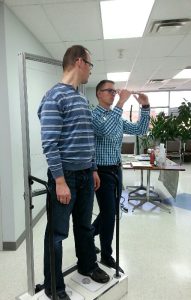


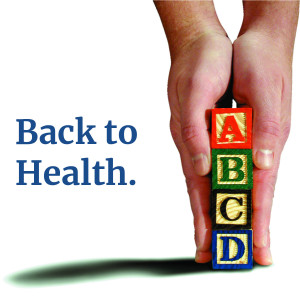
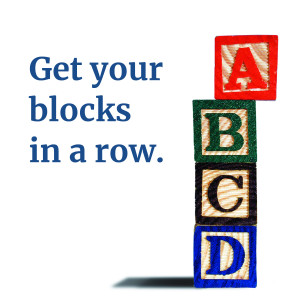

Out of line?
Is evaluating posture that easy?
You evaluate postures every day when looking at your family and friends. It can be easy, but you also have to purposefully pay attention to it as small changes in posture can make a big impact on your body’s ability mechanically, physiologically, and neurologically.
The more difficult aspect of analyzing posture is through the leg length reactivity evaluation. This is how I evaluate patient postures in my Chiropractic office every day. When the patient is lying down on the table, if their is any deviation in their posture it is magnified down to their feet, which showcases in a short or long leg. Through challenging your body through different movements while analyzing your leg lengths, I can help you fine tune your posture towards the ideal posture.
Is there an ideal posture?
There are definitely better and worse postures. However, an ideal posture is not something that once you have you have forever. It is something that you must continually strive towards. You may never reach the hypothetical perfect posture, but the closer you get to it and the longer you have it the better your body will function.
You also don’t want to sit or stand constantly in a perfect posture as the body is designed to be moving!
Posture? Who cares? You should!
Want to do something about your posture?
Contact our office for a posture screening or a full chiropractic exam to test your posture.
Chiropractic is for you!
Chiropractors are trained to specifically measure, analyze, and encourage you towards better posture and better health.
What exercises can I do for my posture?
These are my favourite posture exercises to do myself, and the ones I frequently suggest to patients:
Chin Tuck – We are typically hunched forward “zooming” into a computer screen. If you notice yourself doing this, pull your chin back with your head above your shoulders. Keep your shoulders back and low and your eyes looking straight forward (don’t look down). If you are doing this properly, you will give yourself three chins… So don’t do this in front of others. I usually suggest holding it for 5-10 seconds frequently throughout the day. You can do this in the car, at your desk, standing, lying down, or sitting.
Reach Back – If you ever find your shoulders slouched forward…stop…and reach back. Spread your arms back in a wing like position and pinch your shoulder blades together low.
Reach up – Reaching up above your head is an excellent way to stretch and take pressure off your back’s slouching positions.
Movement – The best sitting posture is one where you are constantly moving. So keep changing your sitting posture! This is discussed further in Sitting Kills Moving Heals. You’ll even notice in the Straighten Up Canada app from the Canadian Chiropractic Association that the majority of posture exercises are about getting movement back into your body. I highly suggest you check them out at http://www.chiropractic.ca/straighten-up-canada/
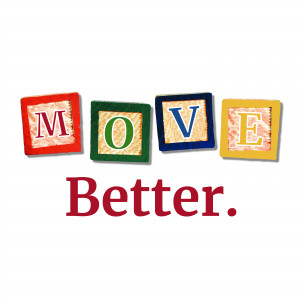
Practice Body Awareness – I always try to get my patients to be aware of the signals their body
is telling them, and to listen to those internal innate signals. These hints the body gives you aren’t always pain, but are typically stiffness, discomfort, irritation, etc. It will be different for each person, so if you can figure out the hints your body tells your throughout your day, your body will thank you with better health. Practicing body awareness means to move when your body tells you to move, rest when it says rest. This is important in our busy, convenient, and sitting lives. Listen to your body…Get up and Move!
Find balance in your activities – Don’t just work out one side of your body. Strive to find balance in all your activities.
Core Exercises – Be careful with core exercises. The core muscles are very important for proper posture, but often my patients are injured from improper core exercises. Improper core exercises put too much strain on the spine. They typically include core exercises that have bending or twisting involved in the low back. Don’t do sit-ups. Don’t constantly twist the low back when holding weights. Yes, you will get stronger muscles, but at the expense of an injured back. Better core exercises will strengthen the muscles but not over load or strain the joints. Examples of better core exercises are planks, side bridges, or back bridges. “Bird Dogs” are another core exercise that trains the low back muscles towards encouraging a proper posture. For more information on these exercises, connect with me or read up on the books by Stuart McGill.
I encourage you to get the app Straighten Up Canada from the Canadian Chiropractic Association and to share with your friends and family members your favourite posture exercises.
Why again is posture so important?
People have been making a big deal about “posture” for centuries. Remember those old television ads that show ladies walking around with text-books on their heads, mumbling “the rain in Spain…falls mainly…in the plain?” Why were they – and why are we still making posture such a big deal? Because…
Excellent posture is not only beautiful to look at, but it also reflects self-confidence. This can be beneficial in any environment where you want to be more impressive, like at a job interview or on a first date? Improper posture causes misalignment in your spine, and this can put excessive stress and strain on muscles, joints, and the supporting connective tissues.
Posture can even impact your brain! Research on this topic is highlighted in Amy Cuddy’s book called Presence and discusses how being in different postures can impact the brain, how you feel, and how you perform. Being in a powerful posture can help you be more confident and perform better. Being in a collapsed depressed posture will encourage your brain to set into a depressed state! From what you learned above, you know that you can change your postures. Change your posture – Change your brain! You are worth it! Watch her TED talk.
Regardless of which type of posture you are talking about, one of the most important factors in good posture is the proper curvature of your spine. The spinal column is made up of 26 bones stacked one on top of another, combined to form 4 different postural curves from top to bottom: cervical, thoracic, lumbar, and sacral as shown in the attached link.
Any alteration in the natural curves of the spine will also lead to vertebral subluxations. These are specific areas of the spine where one vertebra does not move properaly relative to another. When this happens, nerves that exit the spine at the level of the subluxation can become irritated, as well as the muscles attached to these vertebrae. If these areas are not adjusted by your Chiropractor, then function will not be restored, leading to chronically tight and restricted segments. Long-term, this makes it near impossible to maintain proper posture.
Some new research in 2015 has shown degenerative changes in the spine can be influenced by your posture! Check out this article:
Dr. Peever learns from the American Posture Institute at CalJam 2017
I was fortunate to get to see Dr. Krista Burns from the American Posture Institute speak at one of the biggest Chiropractic conferences in the world, California Jam 2017. Dr. Krista brought an excellent presence to the stage and was able to share a few things about how important posture is to the brain. She mentioned a new phrase that I hadn’t hear of before, “Digital Dementia”. The forward head posture that we are seeing so often in our desk workers and youth is unfortunately linked to signs of dementia in kids! It is also linked to early mortality, heart attacks, depression, and asthma!
“[Forward spinal posture or kyphosis] may be associated with adverse health consequences including impaired physical function, pain and disability, impaired pulmonary function, and increase mortality” – Progressive Spinal Kyphosis in the Aging Population 2015
Fortunately, the solutions are simple. Unfortunately, you do have to do something about it. Getting upright takes effort, but is essential for you to be a fully functioning human being. Get your head up!
Dr. Krista also talked on practical tests regarding posture and the brain or neurology. These we do use often in our Chiropractic office in Caledonia and are of great help to understand how deep the problem has become into a person’s “muscle memory” or brain patterns.
The excercises that Dr. Krista mentioned were regarding extension exercises for the spine as well as sitting on wobble boards or cushions. This makes it difficult for your brain to maintain a simple “comfortable” balance and prevents it from becoming lazy. A lazy brain may be “comfortable” but is definitely NOT healthy.
If you sit or use mobile devices often, you will need to place more emphasis on your postures. To start, stand up and look around you. Next, schedule a chiropractic appointment to help!
Dr. Callum Peever – Chiropractor in Caledonia.
The Best Chiropractic Posture Exercise in The World
This is the chiropractic posture exercise that a mentor of mine, Dr. Cote, considers to be the best chiropractic posture exercise in the world. Our patients at our chiropractic clinic in Caledonia think so too!
- First lie on the floor (carpeted floor is better) or a yoga mat will do. Your knees should be bent with your feet on the floor.
- Your arms should be along the side of your body, with your hands in contact with your thighs.
- From this starting position slide your arms along the floor as high as you can without experiencing pain (like making a snow angel). In this arm position relax your arms, upper back, and neck muscles and count to 20.
- After this, return your arms to the starting position by sliding them down on the floor the whole way.
- Repeat this 6 times. This exercise will be more effective if you can do it once or twice a day.
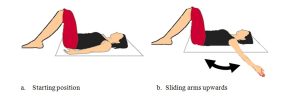
This is the best chiropractic posture exercise in the world according to Dr. Cote
It is important to remember to do these back posture exercises slowly, don’t rush the movement and make sure your arms are in contact with the floor the whole time.
Discuss these back posture exercises with your Chiropractor!
Forward Head Posture with Anterolisthesis improved with Chiropractic
This following article discusses the impact that a bone in the neck can have on the body when “slipped forward”, and the surgical and chiropractic approach to helping the patient. Trauma is a factor to this “slipping forward”, but also bad posture over a long period of time. The chiropractic care to address the spinal posture was able to greatly help the patient and reduce the amount the neck bone was “slipped forward”. Ideally, this can help a person who would like to avoid having neck surgery to address a degenerative cervical Spondylolisthesis (slipped bone) but can also be a good reminder for people about how important posture can be.
-Dr. Callum Peever – Chiropractor in Caledonia
Abstract
“Objective: The purpose of this study is to report on the structural and symptomatic improvements made in a patient with a cervical spondylolisthesis using Chiropractic BioPhysics Technique.”
“Clinical Features: A 52-year-old female presented for chiropractic care with frequent and severe neck pain, neck stiffness, and pain in the upper back. A neutral lateral cervical x-ray displayed anterolisthesis at C4-C5 measuring 2.4mm (ideal is 0mm). Also present was an anterior head translation.”
“A 52-year-old female presented with neck pain, neck stiffness, and thoracic pain. The patient indicated that she experienced the pain frequently and that the pain was severe and produced a tense and swelling sensation to her lower cervical and upper thoracic areas. The patient denied a history of trauma to the area.”
“Intervention and Outcomes: The patient received chiropractic care 30 times over 3 months using Chiropractic BioPhysics technique protocols. Follow-up examination revealed that the patient achieved a correction of her C4-C5 spondylolisthesis from 2.4mm to 0.7mm. Her anterior head translation was reduced from 19.6mm to 9.0mm, and the absolute rotational angle from C2-C7 improved from -22.8° to -26°. The patient also reported a resolution of her pain, stiffness, tension and swelling symptoms.”
“Conclusion: This case study demonstrates the successful reduction of cervical spondylolisthesis and improvement of sagittal spinal alignment and cervical lordosis in a 52-year old female with cervicothoracic pain and postural abnormalities using Chiropractic BioPhysics technique. Further research is suggested for either a case series or a clinical trial to see how conservative chiropractic care can negate the need for surgical intervention of cervical spondylolisthesis.”
“Degenerative cervical spondylolisthesis (DCS)”
“Spondylolisthesis of the spine refers to an anterior or posterior displacement of the vertebrae relative to the vertebrae below.”
“DCS occurs secondary to a degenerative cascade starting with joint narrowing, marginal osteophytes, and bone fragmentation eventually leading to capsular laxity.”
“Often the first symptom of a spondylolisthesis is neck pain. Patients may also present with signs of varying levels of neurological compromise. The possible consequences of untreated DCS include worsening pain, myelopathy, radiculopathy, and in rare cases, vertebral artery stenosis.”
Surviving Your Commute
Apparently every 17.9 years you are in a car accident. But everyday we sit poorly during our commutes. This daily static posture has negative long and short term effects on our health that we can change.
If you can’t change your commute times, definitely start working on your commuting postures.
The secret to a great posture is to continuously change your posture! From your head position to your hips. Keep shifting around.
My patients find that once they begin listening to their body with the help of Chiropractic care, this becomes innate. They move when their body tells them too.
Better health is as simple as that.
Movement is life and the absence of movement is…
Appreciate and Celebrate Life,
Dr. Callum Peever
Poor Posture isn’t a new problem
Posture problems aren’t new. Here is a pamphlet cover from the 80’s encouraging that good posture works and the poor posture hurts. The pam
phlet encourages good standing posture, good posture in motion, and posture exercises. It discusses the three natural curves in your spine (cervical, thoracic, and lumbar curve).
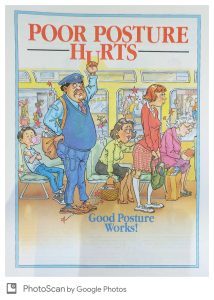
How does good posture feel?
“You know you’re in good posture when you can feel your ears, shoulders, pelvis, knees, and ankles lined up on the plumb line. So take a minute to close your eyes and really feel your body position in space. The more ‘body aware’ you are, the easier it is to find and fix a problem.” – More and more people are becoming less body aware, which is making these posture assessments, such as the one indicated above from this pamphlet easily usable. Someone that is under Chiropractic care will have a much easier time becoming ‘body aware’ and using these types of exercises to determine if their postures are in, or out! We often have patients at the office tell us that they are here to get adjusted because they are ‘out of alignment’, or fee that their ‘hips are crooked’, or ‘one foot feels longer than the other’. Some patients notice this in their walking, driving, sitting, standing, or sports. One patient notices that her stirrups when riding on her horse feel lopsided. Fortunately, Chiropractic helps her find her balance and proper posture! Helping her perform better on her horse! Posture matters!


